What if you had never seen a picture of yourself before? What if you had only seen pictures of yourself that someone you barely knew had taken? As someone who has photographed and been photographed all her life, it is difficult to imagine. But, in that situation, what kind of power does a photograph (and therefore, a photographer) have?
Continue Reading February 11, 2010 at 4:18 am
Last week, I wrote about Avatar and its representation of an indigenous society. In response, a friend forwarded me this Op-Ed by David Brooks, where he takes my criticisms quite a few steps further.
The White Messiah fable, says Brooks, is offensive because, “It rests on the stereotype that white people are rationalist and technocratic while colonial victims are spiritual and athletic. It rests on the assumption that nonwhites need the White Messiah to lead their crusades. It rests on the assumption that illiteracy is the path to grace. It also creates a sort of two-edged cultural imperialism. Natives can either have their history shaped by cruel imperialists or benevolent ones, but either way, they are going to be supporting actors in our journey to self-admiration.
“It’s just escapism, obviously, but benevolent romanticism can be just as condescending as the malevolent kind — even when you surround it with pop-up ferns and floating mountains.”
I love this. He says it so clearly. And that clarity is helpful, because in practice this is a complex issue that can be difficult to understand and to spot. As a photographer who is interested in social change, I have been a “benevolent imperialist.” And that’s not what I want to be. I worry about seeing myself as an agent of positive social change when I am actually exacerbating a social divide.
And here’s why. It’s very easy to come from relative affluence (which you do, in this world, if you own a camera) and try to work for the betterment of others as an outsider, and end up further marginalizing or denigrating the very people you seek to assist.
For example, I worked for the International Rescue Committee in Tanzania in 2005, and part of my job was to document the work they were doing in the refugee camps along the border with Burundi. In that area, malnutrition can sometimes be an issue.

Juan Arredondo on behalf of the International Rescue Committee
I was making pictures in the hospitals, which the IRC ran, and I met a woman seeking treatment for her malnourished child. I asked the woman if I could photograph her.
She was extremely embarrassed. It took her a few moments to muster the courage to say anything. She said I could photograph the child, but not her face. She covered herself with a scarf. A hospital worker turned to me and said, “She is ashamed because her child is malnourished.”
When I think about that incident, I feel gross. Of course she was embarrassed! I would be embarrassed! Is there any mother who wouldn’t be? Can you imagine how awful she felt? Why was I so thickheaded? How did I think she would feel? Did I think she didn’t have feelings? Did I think she would feel differently than I would in the same situation?
I humiliated a woman. I basically coerced her into being photographed because I represented an agency that was giving her assistance. And I made what was already a very painful, stressful situation for her significantly worse.
It is I who am now ashamed when I talk about this.
And I wonder, how can I do better next time? How can I see these moments coming more effectively? What are the attitudes I need to change? What are the approaches I can take that will allow me to be more respectful and considerate of others?
Inherent within this discussion is the question of whether it is possible to make great art about a community as an outsider to that community. In her comment on last week’s post, reader Sittingpugs said, “Smoke Signals is indeed an amazing film not only because of its quality acting, directing, and writing, but also because the ethnic minority experience is told from within (not to say that an ethnic “majority” artist couldn’t create an equally authentic story or that every piece of ethnic cinema features Truths).”
I’ve had writing teachers that said, “Write only what you know!” and others that said, “Write what you don’t know!”
I think great art surprises us—it can come from anywhere, and be about anything. So I don’t think you have to be from a community to chronicle it with beauty and subtlety. But, it’s also very easy to become a hapless messiah, a benevolent imperialist, or simply someone who is not actually helping anyone. Especially with photography, there are issues of exploitation, power dynamics, and simply knowing where to be that make working with a community difficult to negotiate for an outsider. It’s still worth doing, but it’s also worth thinking and talking about.
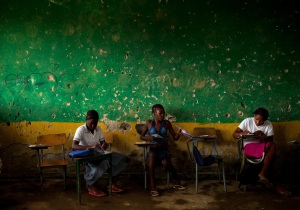
Juan Arredondo on behalf of the IRC
And these photographs, by Juan Arredondo on behalf of the IRC in Colombia, are really nice. As always, you can click on the images to see his full photo essay, or click here.
January 14, 2010 at 5:03 am
How do you make images about a debilitating disease that keep the dignity, the complexity, and the feelings of the subjects intact?
How do you create images about this issue without further injuring those people who suffer from it?
In her photo essay for the Turkish Association for the Fight Against Leprosy, Delizia Flaccavento uses a direct, narrative, sometimes impersonal approach. She focuses on the symptoms and scars of leprosy.
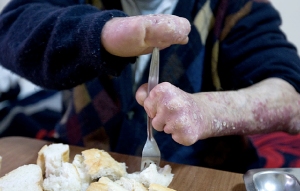
I appreciate those photographs. They teach me something I want to know–what leprosy really looks like.
And they take two simultaneous risks: 1. that I will look away because I feel distressed. 2. that I won’t look away because I am interested—not in the people, but in the spectacle of the disease.

They also tell the story of an organization, rather than an individual.
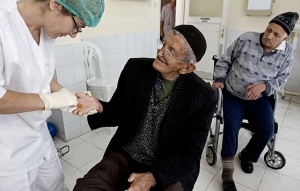
Which, like cropping out or obscuring faces, can occasionally be a more sensitive way to represent a person.
Jan Sochor takes another approach in his photograph of a patient with leprosy in Haiti. He makes this person’s infected feet seem abstract and strange. They are barely recognizable.

This picture dissociates me from the personality connected to those feet. Similar to some of Flaccavento’s pictures, I don’t see a being here so much as I see a disease. The feet are gruesome. I feel revulsion and alarm. (Jan Sochor also has an essay about Haiti posted on PhotoPhilanthropy.org although this picture is from his blog.)
Ehrin Macksey does something very different again. His photographs of a leprosy colony in Vietnam–for Send Me/Kairos Coalition–depict the lives of the people in the village more than they depict the disease itself. In his images, the dock where a woman cleans her vegetables
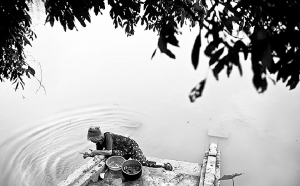
or the monthly rations of meat each person receives
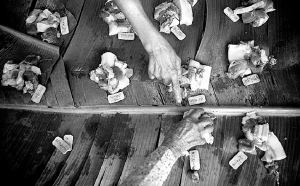
or the prayers said in a Buddhist temple

are points of entry for a visitor to this town. In his images I am aware of many lives, all intertwined. I’m aware of time: a past and a future. There is a disease in the village, but there are also people.
In spite of the harsh light, this photograph of a man named Bop feels tender. I find my mind lingering, holding onto it for a moment.
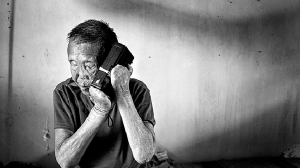
Each of these artists tells an important story. Each is searching for a way to gingerly illustrate an issue that can be hard to look at.
December 16, 2009 at 10:39 pm









